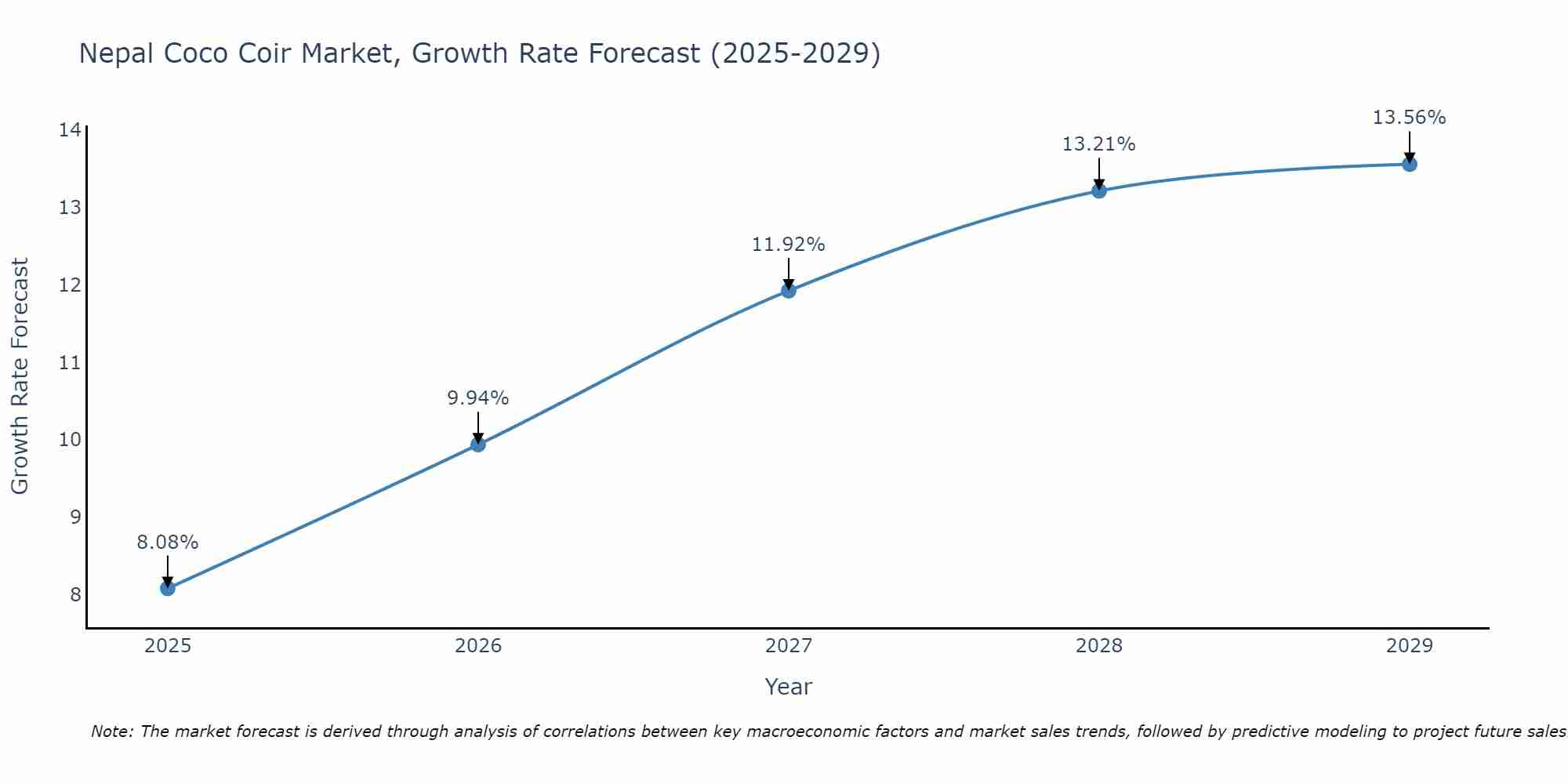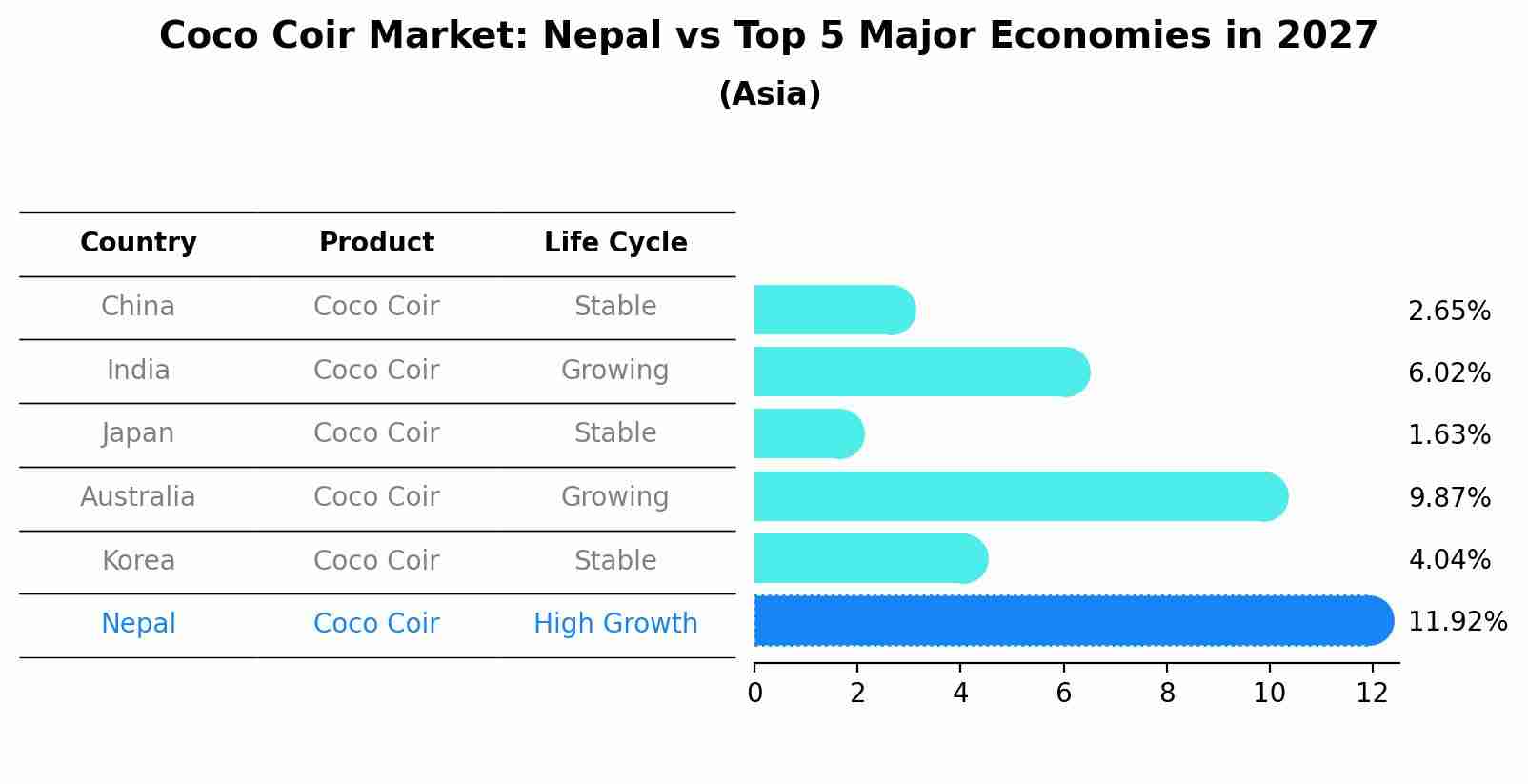Nepal Coco Coir Market (2025-2031) Outlook | Trends, Value, Growth, Size, Share, Industry, Companies, Forecast, Revenue & Analysis
| Product Code: ETC373716 | Publication Date: Aug 2022 | Updated Date: Jul 2025 | Product Type: Market Research Report | |
| Publisher: 6Wresearch | Author: Sachin Kumar Rai | No. of Pages: 75 | No. of Figures: 35 | No. of Tables: 20 |
Nepal Coco Coir Market Size Growth Rate
The Nepal Coco Coir Market is poised for steady growth rate improvements from 2025 to 2029. From 8.08% in 2025, the growth rate steadily ascends to 13.56% in 2029.

Coco Coir Market: Nepal vs Top 5 Major Economies in 2027 (Asia)
In the Asia region, the Coco Coir market in Nepal is projected to expand at a high growth rate of 11.92% by 2027. The largest economy is China, followed by India, Japan, Australia and South Korea.

Nepal Coco Coir Market Synopsis
The Nepal Coco Coir market is experiencing steady growth due to increasing awareness among farmers about the benefits of using coco coir as a sustainable alternative to traditional soil mediums. The market is primarily driven by the rising demand for organic and eco-friendly agricultural products. Coco coir is widely used in horticulture, agriculture, and landscaping sectors in Nepal due to its water retention properties, aeration benefits, and biodegradability. The market is characterized by the presence of both domestic and imported coco coir products, with a growing trend towards using locally produced coco coir to support the country`s agricultural industry. Government initiatives promoting sustainable farming practices further contribute to the market`s growth potential, making Nepal a key player in the regional coco coir market.
Nepal Coco Coir Market Trends
The Nepal Coco Coir market is experiencing growth due to increasing awareness about sustainable and eco-friendly gardening practices. Consumers are increasingly opting for coco coir as a substitute for traditional peat moss due to its renewable and biodegradable nature. The market is witnessing a rise in demand for coco coir products, such as growing medium, mulch, and soil amendment, driven by the growing trend of urban gardening and indoor plants. Additionally, the agricultural sector in Nepal is also adopting coco coir for its water retention properties and ability to improve soil structure. As the government emphasizes sustainable agricultural practices, the Nepal Coco Coir market is expected to continue its upward trajectory in the coming years.
Nepal Coco Coir Market Challenges
In the Nepal Coco Coir Market, challenges primarily revolve around limited awareness and understanding of the product among local farmers and gardeners. The lack of knowledge about the benefits and applications of coco coir hinders its widespread adoption in agricultural practices. Additionally, the availability and consistency of high-quality coco coir products may be a concern due to limited local production facilities and reliance on imports. Pricing fluctuations, transportation costs, and competition from traditional growing mediums further complicate market dynamics. Addressing these challenges will require targeted education and marketing efforts to increase awareness, as well as investments in local production capabilities to ensure a stable supply chain and competitive pricing in the Nepal Coco Coir Market.
Nepal Coco Coir Market Investment Opportunities
The Nepal Coco Coir market presents promising investment opportunities due to the increasing demand for eco-friendly and sustainable alternatives to traditional gardening and agriculture products. Coco coir, derived from coconut husks, is known for its excellent water retention and aeration properties, making it a popular choice for soil amendments, hydroponic growing mediums, and erosion control applications. As the awareness of environmental issues grows, the demand for coco coir is expected to rise further. Investors can explore opportunities in establishing coco coir processing facilities, expanding distribution networks, and developing innovative coco coir products tailored to the local market needs. Collaborating with local coconut farmers to ensure a sustainable and reliable supply chain can also be a strategic investment approach in the Nepal Coco Coir market.
Jordan Agar Market Government Policies
The Nepal government has implemented various policies related to the coco coir market, including providing subsidies and incentives to promote the production and export of coco coir products. The government has also focused on increasing research and development in the sector to enhance product quality and innovation. Additionally, regulations have been put in place to ensure sustainable harvesting practices and environmental protection in the production of coco coir. The government has also encouraged private sector participation and investment in the industry through favorable policies and support programs. Overall, the government`s policies aim to boost the growth of the Nepal coco coir market while ensuring sustainability and quality standards are maintained.
Nepal Coco Coir Market Future Outlook
The future outlook for the Nepal Coco Coir Market appears promising with a projected increase in demand driven by the growing awareness of sustainable and eco-friendly alternatives to traditional peat moss and soil. As more farmers and gardeners embrace organic practices, the use of coco coir as a soil amendment and growing medium is expected to rise. Additionally, the versatility of coco coir in various applications such as hydroponics, landscaping, and erosion control further contributes to its market potential. The government`s initiatives to promote agriculture and horticulture practices that are environmentally friendly could also boost the adoption of coco coir products. Overall, the Nepal Coco Coir Market is likely to experience steady growth in the coming years as consumers seek more sustainable options in the agricultural sector.
Key Highlights of the Report:
- Nepal Coco Coir Market Outlook
- Market Size of Nepal Coco Coir Market, 2024
- Forecast of Nepal Coco Coir Market, 2031
- Historical Data and Forecast of Nepal Coco Coir Revenues & Volume for the Period 2021 - 2031
- Nepal Coco Coir Market Trend Evolution
- Nepal Coco Coir Market Drivers and Challenges
- Nepal Coco Coir Price Trends
- Nepal Coco Coir Porter's Five Forces
- Nepal Coco Coir Industry Life Cycle
- Historical Data and Forecast of Nepal Coco Coir Market Revenues & Volume By Product for the Period 2021 - 2031
- Historical Data and Forecast of Nepal Coco Coir Market Revenues & Volume By Coco Coir Grow Bags for the Period 2021 - 2031
- Historical Data and Forecast of Nepal Coco Coir Market Revenues & Volume By Bales for the Period 2021 - 2031
- Historical Data and Forecast of Nepal Coco Coir Market Revenues & Volume By Coir Material for the Period 2021 - 2031
- Historical Data and Forecast of Nepal Coco Coir Market Revenues & Volume By Open Tops for the Period 2021 - 2031
- Historical Data and Forecast of Nepal Coco Coir Market Revenues & Volume By Blends & Loose Substrate for the Period 2021 - 2031
- Historical Data and Forecast of Nepal Coco Coir Market Revenues & Volume By Others for the Period 2021 - 2031
- Historical Data and Forecast of Nepal Coco Coir Market Revenues & Volume By Application for the Period 2021 - 2031
- Historical Data and Forecast of Nepal Coco Coir Market Revenues & Volume By Rope & Cordage for the Period 2021 - 2031
- Historical Data and Forecast of Nepal Coco Coir Market Revenues & Volume By Coco Nets & Twines for the Period 2021 - 2031
- Historical Data and Forecast of Nepal Coco Coir Market Revenues & Volume By Stitched Mats for the Period 2021 - 2031
- Historical Data and Forecast of Nepal Coco Coir Market Revenues & Volume By Coconut Meals for the Period 2021 - 2031
- Historical Data and Forecast of Nepal Coco Coir Market Revenues & Volume By Husk for the Period 2021 - 2031
- Historical Data and Forecast of Nepal Coco Coir Market Revenues & Volume By Others for the Period 2021 - 2031
- Historical Data and Forecast of Nepal Coco Coir Market Revenues & Volume By Consumer for the Period 2021 - 2031
- Historical Data and Forecast of Nepal Coco Coir Market Revenues & Volume By Green Houses for the Period 2021 - 2031
- Historical Data and Forecast of Nepal Coco Coir Market Revenues & Volume By Sellers for the Period 2021 - 2031
- Nepal Coco Coir Import Export Trade Statistics
- Market Opportunity Assessment By Product
- Market Opportunity Assessment By Application
- Market Opportunity Assessment By Consumer
- Nepal Coco Coir Top Companies Market Share
- Nepal Coco Coir Competitive Benchmarking By Technical and Operational Parameters
- Nepal Coco Coir Company Profiles
- Nepal Coco Coir Key Strategic Recommendations
Frequently Asked Questions About the Market Study (FAQs):
- Single User License$ 1,995
- Department License$ 2,400
- Site License$ 3,120
- Global License$ 3,795
Search
Related Reports
- Saudi Arabia Manlift Market (2025-2031) | Outlook, Size, Growth, Trends, Companies, Industry, Revenue, Value, Share, Forecast & Analysis
- Uganda Excavator, Crane, and Wheel Loaders Market (2025-2031) | Strategy, Consumer Insights, Analysis, Investment Trends, Opportunities, Growth, Size, Share, Industry, Revenue, Segments, Value, Segmentation, Supply, Forecast, Restraints, Outlook, Competition, Drivers, Trends, Demand, Pricing Analysis, Competitive, Strategic Insights, Companies, Challenges
- Rwanda Excavator, Crane, and Wheel Loaders Market (2025-2031) | Strategy, Consumer Insights, Analysis, Investment Trends, Opportunities, Growth, Size, Share, Industry, Revenue, Segments, Value, Segmentation, Supply, Forecast, Restraints, Outlook, Competition, Drivers, Trends, Demand, Pricing Analysis, Competitive, Strategic Insights, Companies, Challenges
- Kenya Excavator, Crane, and Wheel Loaders Market (2025-2031) | Strategy, Consumer Insights, Analysis, Investment Trends, Opportunities, Growth, Size, Share, Industry, Revenue, Segments, Value, Segmentation, Supply, Forecast, Restraints, Outlook, Competition, Drivers, Trends, Demand, Pricing Analysis, Competitive, Strategic Insights, Companies, Challenges
- Angola Excavator, Crane, and Wheel Loaders Market (2025-2031) | Strategy, Consumer Insights, Analysis, Investment Trends, Opportunities, Growth, Size, Share, Industry, Revenue, Segments, Value, Segmentation, Supply, Forecast, Restraints, Outlook, Competition, Drivers, Trends, Demand, Pricing Analysis, Competitive, Strategic Insights, Companies, Challenges
- Israel Intelligent Transport System Market (2025-2031) | Strategy, Consumer Insights, Analysis, Investment Trends, Opportunities, Growth, Size, Share, Industry, Revenue, Segments, Value, Segmentation, Supply, Forecast, Restraints, Outlook, Competition, Drivers, Trends, Demand, Pricing Analysis, Competitive, Strategic Insights, Companies, Challenges
- Uganda Precast and Aggregate Market (2025-2031) | Strategy, Consumer Insights, Analysis, Investment Trends, Opportunities, Growth, Size, Share, Industry, Revenue, Segments, Value, Segmentation, Supply, Forecast, Restraints, Outlook, Competition, Drivers, Trends, Demand, Pricing Analysis, Competitive, Strategic Insights, Companies, Challenges
- Australia IT Asset Disposal Market (2025-2031) | Strategy, Consumer Insights, Analysis, Investment Trends, Opportunities, Growth, Size, Share, Industry, Revenue, Segments, Value, Segmentation, Supply, Forecast, Restraints, Outlook, Competition, Drivers, Trends, Demand, Pricing Analysis, Competitive, Strategic Insights, Companies, Challenges
- UAE Building Thermal Insulation Market Outlook (2025-2031) | Revenue, Companies, Share, Trends, Growth, Size, Forecast, Industry, Analysis & Value
- Portugal Electronic Document Management Market (2025-2031) | Strategy, Consumer Insights, Analysis, Investment Trends, Opportunities, Growth, Size, Share, Industry, Revenue, Segments, Value, Segmentation, Supply, Forecast, Restraints, Outlook, Competition, Drivers, Trends, Demand, Pricing Analysis, Competitive, Strategic Insights, Companies, Challenges
Industry Events and Analyst Meet
Our Clients
Whitepaper
- Middle East & Africa Commercial Security Market Click here to view more.
- Middle East & Africa Fire Safety Systems & Equipment Market Click here to view more.
- GCC Drone Market Click here to view more.
- Middle East Lighting Fixture Market Click here to view more.
- GCC Physical & Perimeter Security Market Click here to view more.
6WResearch In News
- Doha a strategic location for EV manufacturing hub: IPA Qatar
- Demand for luxury TVs surging in the GCC, says Samsung
- Empowering Growth: The Thriving Journey of Bangladesh’s Cable Industry
- Demand for luxury TVs surging in the GCC, says Samsung
- Video call with a traditional healer? Once unthinkable, it’s now common in South Africa
- Intelligent Buildings To Smooth GCC’s Path To Net Zero













